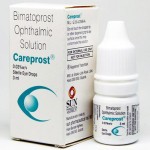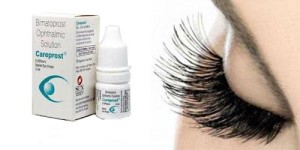 Bimatoprost is a synthetic drug that chemically resembles Prostaglandins. Prostaglandins are hormones produced by the body and have several functions such as controlling the relaxation and contraction of smooth muscles. Bimatoprost mimics the function of the prostaglandin prostamide. It is used externally for treating two conditions that can affect the eye. These are:
Bimatoprost is a synthetic drug that chemically resembles Prostaglandins. Prostaglandins are hormones produced by the body and have several functions such as controlling the relaxation and contraction of smooth muscles. Bimatoprost mimics the function of the prostaglandin prostamide. It is used externally for treating two conditions that can affect the eye. These are:
- Bimatoprost is used in reducing intraocular pressure (IOP)
The drug increases the outward flow of aqueous fluid out of the eye through the trabecular meshwork and through the uveoscleral route. - It is also used in treating open angle glacoma
Bimatoprost slows down the progression of open angle glacoma. However, the drug is not effective in treating narrow angle glacoma and neovascularglacoma.
Other than the above two functions, bimatoprost has been linked to two cosmetic effects. These include the following:
- Bimatoprost causes an increased growth of the eyelashes
The drug prolongs the growth period of growth of eye lashes. This results in longer, darker and thicker eyelashes. - The prostaglandin analog causes a reduction in orbital adipose tissue
The orbital adipose tissue refers to the fat that stored around the eyes. The drug Bimatoprost reduces the fat around the eyes. This makes Bimatoprost a viable remedy for the condition commonly known as crow’s feet characterized by hollows beneath the eyes.
 It is the active ingredient in Lumigen, a topical eye medication made by Allergen. Lumigen is a clear, isotonic 0.03% Bimatoprost preparation. It contains other inactive ingredients which include benzalkonium chloride, sodium chloride, sodium phosphate, citris acid and purified water. Users of contact lenses need to wait atleast 15 minutes after using Lumigen. This is because benzalkonium chloride can get absorbed into the lense reducing their effectiveness.
It is the active ingredient in Lumigen, a topical eye medication made by Allergen. Lumigen is a clear, isotonic 0.03% Bimatoprost preparation. It contains other inactive ingredients which include benzalkonium chloride, sodium chloride, sodium phosphate, citris acid and purified water. Users of contact lenses need to wait atleast 15 minutes after using Lumigen. This is because benzalkonium chloride can get absorbed into the lense reducing their effectiveness.
Mode of action
Intraocular pressure is a condition that arises when excess aqueous humor(fluid) accumulates in the eye. If left untreated, the condition leads to the damage of the optical nerve, finally resulting in total loss of vision. Bimatoprost reduces ocular hypertension (pressure) by increasing the flow of the aqueous fluid out of the eye. The fluid flows out through two channels namely:
-
Trabecular meshwork
The trabecular meshwork is a system of tubes located below the cornea. The tubes drain the excess aqueous fluid back into the blood stream.
-
Uveoscleral route
This route refers to the manner in which aqueous fluid seeps into surrounding tissue, finally ending up as part of the inter cellular fluid. The inter cellular fluid end up in the blood stream via the lymphatic system.
Cosmetic use
 Stimulation of eye lash growth
Stimulation of eye lash growth
Bimatoprost activates the prostamide alpha F2 receptor in eye lash hair follicles. The prostaglandin, prostamide, then prolongs the growth period of the eye lashes which allow the eyes to thicken and lengthen. Bimatoprost also causes an increase in the natural pigment melanin. The pigment is responsible for the darkening of eye lashes.
Reduction of orbital adipose tissue
The activation of the prostaglandin prostamide prevents the differentiation and survival of adipose tissue around the eyes. This allows for the enzymatic breakdown of fat stored in the tissue.
Use and dosage
The following steps should be followed when self-administering the drug.
- The face and hands are cleaned with soapy water. The face and hand are then dried thoroughly.
- Using one hand, the lower eyelid is gently pulled away from the eye and a single drop of a 0.03% Bimatoprost placed in the pouch. The eyes is then closed immediately.
- Using a finger the lower lid is massaged to spread the drug throughout the eye. The eyes should remain closed for at least 5 minutes.
One drop of 0.03% Bimatoprost (Lumigen) is used for each eye. This should be done in the evening unless otherwise indicated by a qualified physician. The treatment should last for the period indicated by the doctor. You should always consult your doctor before you buy Bimatoprost
For cosmetic use, the 0.03% Bimatoprost preparation is applied in the skin near the eyelashes using an applicator. Care should be taken to prevent the preparation from getting on any other part of the face. This is done twice a day until the desired effect is achieved.
Side effects
A number of side effects have been reported by users of Bimatoprost. These include:
- Permanently darkened eye rashes
- Permanent pigmentation of the iris to a brownish color
- Unexpected hair growth on area that got into contact with the Bimatoprost preparation such as the cheek.
- Inward growth of eyelashes that end up scratching the cornea causing irritation
- Blurred vision and photophobia (light sensitivity)

